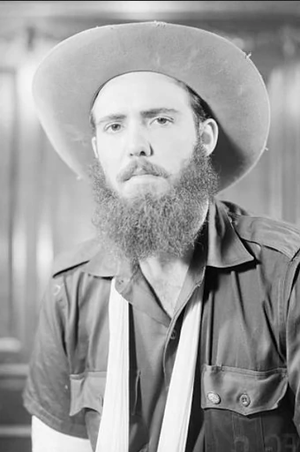Rolando Cubela
(soldier, doctor) | |
|---|---|
 | |
| Born | 1932 Cuba |
| Nationality | Cuban |
Cuban revolutionary leader who later became "an important asset" of the CIA, and worked with them on plots to assassinate Fidel Castro. | |
Rolando Cubela Secades[1]) is a Cuban revolutionary leader who played a vital part in the Cuban Revolution, being a founder member of the Directorio Revolucionario Estudantil and later the military leader of the DRE's Escambray Mountain front,[2] achieving the rank of Commander, the highest military rank in the Revolutionary Army.
After the Revolution succeeded in 1959, Cubela became Cuba's envoy to UNESCO. Under the cryptonym AM/LASH, Cubela became "an important asset" of the Central Intelligence Agency, and worked with them on plots to assassinate Fidel Castro.[3] In 1966 Cubela was arrested for plotting the assassination of Castro, and sentenced to twenty-five years in prison. Released in 1979, he went into exile in Spain.
Career
In 1955 Cubela was a founder member of the Directorio Revolucionario Estudantil (DRE), and was one of eight members of its Executive Council.[4] In 1956 Cubela was part of a DRE group which attempted to assassinate Santiago Rey Perna, a member of Batista's cabinet; Perna was absent at the time of the attack and the group instead assassinated Antonio Blanco Rico,[5] head of Cuban military intelligence.[1] The incident prompted Chief of National Police Rafael Salas Canizares to assault the Haitian Embassy in Havana, where some revolutionaries were seeking political asylum; Canizares and ten revolutionaries were killed.[5] After the assassination Cubela went into exile in the United States in late 1956, returning to Cuba in 1958.[1]
In mid-1958 Cubela was disputing leadership of the Directorio Revolucionario Estudantil with Eloy Gutiérrez Menoyo. Menoyo had developed the Escambray Mountain front which was the center of DRE activity after the failed March 1957 coup attempt in Havana; but Menoyo had joined DRE more recently whilst Cubela was a founder member. Cubela was ultimately recognized as DRE military leader, and Menoyo left the organization.[2] Menoyo formed the Segundo Frente del Escambray, a group that continued the fight against Batista. Years later, after the triumph of the Revolution, many of the Segundo Frente members fought against the new government of Fidel Castro.[6] Cubela leading the DRE was wounded in the Battle of Santa Clara.[1]
After the Cuban Revolution Cubela was appointed Deputy Secretary in the Ministry of Government in 1959, and in October was elected head of the Federación Estudiantíl Universitaria. Cubela made significant contributions in the early months of the revolutionary government to the reconciliation of the different revolutionary groups, and in 1960 to the merger of various youth and student groups.[1] In summer 1960 Cubela met an old friend, Carlos Tepedino, who was by then working for the CIA under the cryptonym AMWHIP.[1] After Cuban leader Fidel Castro had – in Cubela’s view – betrayed the revolution and established a communist dictatorship, Cubela became disenchanted and started plotting with the CIA and other opponents of the Castro government to try to end it and return to a non-socialist course for the country.[6]
Cubela later became "an important asset" of the Central Intelligence Agency under the cryptonym AM/LASH, and worked with them on plots to assassinate Fidel Castro.[3] In October 1963 Cubela met with Desmond Fitzgerald, head of the CIA's Special Affairs Staff, in Paris, over the objections of some SAS staff who considered Cubela a possible dangle or at least a security risk.[7] At another Paris meeting, on 22 November 1963, Cubela received a "poison pen" - a fountain pen with a hypodermic needle to be used to inject Castro with a poison.[8] Nevertheless, Cubela was insisting on a meeting with Attorney General Robert Kennedy before proceeding with the assassination of Fidel Castro. The CIA cautious of "plausible deniability" stalled. In June 1965, however, the Agency terminated its relationship with Cubela for fears the group had been infiltrated[9].
On 28 February 1966 Castro summoned Cubela to his office, and had him arrested for plotting to kill the head of state. The prosecution did not refer to Cubela's pre-1964 CIA contacts or activities, including the 1963 poison pen episode, limiting evidence to 1964-5 activities.[10] After Castro petitioned the court to avoid the death penalty, Cubela was sentenced to twenty-five years in prison.[11] After his pardon by Castro and his release in 1979,[12] he went into exile to Spain, and became a doctor.[13]
References
- ↑ a b c d e f Luis A. Betancourt (2010), Fidel en la mira: testimonio de un aco, Ediciones Akal, p147-8
- ↑ a b Ramón L. Bonachea and Marta San Martin (1974), Cuban Insurrection: 1952-1959, Transaction Publishers, p185
- ↑ a b William J. Chambliss and Marjorie Sue Zatz (1993), Making Law: The State, the Law, and Structural Contradictions, Indiana University Press, p329
- ↑ Bonachea and St Martin (1974:50)
- ↑ a b Bonachea and St Martin (1974:73)
- ↑ a b Faria, Miguel A (2002). Cuba in Revolution — Escape From a Lost Paradise. Macon, GA: Hacienda Publishing. pp. 75–76
- ↑ Evan Thomas (2012), The Very Best Men: The Daring Early Years of the CIA, Simon & Schuster, p138
- ↑ Michael Howard Holzman (2008), James Jesus Angleton, the CIA, and the Craft of Counterintelligence, University of Massachusetts Press, p192
- ↑ Chambliss and Zatz (1993:333)
- ↑ CIA (1967), REPORT ON PLOTS TO ASSASSINATE FIDEL CASTRO (1967 INSPECTOR GENERAL'S REPORT), NARA Record Number: 104-10213-10101. p122
- ↑ Gus Russo and Stephen Molton (2010), Brothers in Arms: The Kennedys, the Castros, and the Politics of Murder, Bloomsbury Publishing, p429
- ↑ "Cuba Frees CIA agent", Ottawa Journal, August 28, 1979, p13
- ↑ Jose M. Cardona (1998), Information Services on Latin America, ISLA, Volume 53, Issue 12